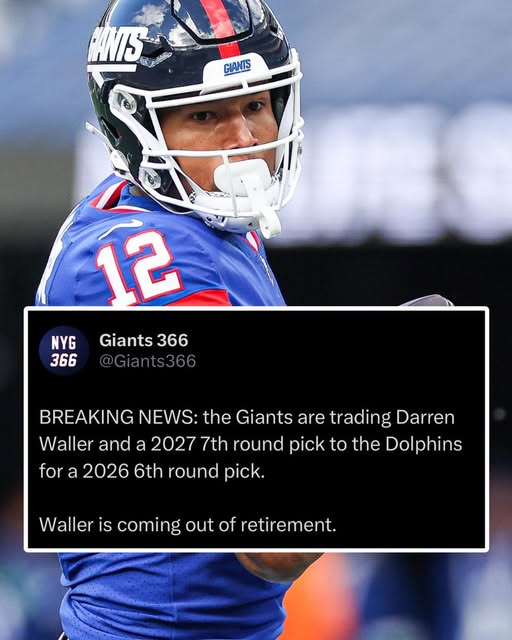Breaking news is sweeping across the NFL landscape as the New York Giants have agreed to trade star tight end Darren Waller to the Miami Dolphins. This blockbuster deal marks a significant shift for both franchises and has major implications for the upcoming NFL season and beyond. The trade not only shakes up the Giants’ roster but also bolsters the Dolphins’ offensive arsenal with one of the league’s most dynamic and versatile tight ends. Fans and analysts alike are now buzzing with anticipation, dissecting the potential impacts and strategic motivations behind this unexpected move.
Darren Waller’s journey to becoming one of the NFL’s premier tight ends is well-documented and serves as a testament to his talent and resilience. Known for his unique combination of size, speed, and agility, Waller has consistently been a nightmare matchup for opposing defenses. Over the years, he has emerged as a reliable offensive weapon, capable of stretching the field vertically, creating mismatches in the passing game, and providing a solid target in clutch moments. His ability to function almost like a wide receiver out of the tight end position makes him a coveted asset for any offense.
For the New York Giants, trading Waller is a surprising decision. The Giants had acquired Waller in hopes of strengthening their passing attack and providing quarterback Daniel Jones with a dependable playmaker. However, the decision to trade him signals a possible shift in the Giants’ offensive philosophy or a move to recalibrate their roster around different priorities. While Waller’s talent is unquestioned, the Giants may be considering factors such as salary cap implications, team chemistry, or a desire to invest in younger players to build for the future. Additionally, the Giants might be seeking to bolster other positions through the assets gained from this trade.
From the Miami Dolphins’ perspective, landing Darren Waller is a major coup. The Dolphins have been steadily building an explosive offense under head coach Mike McDaniel and quarterback Tua Tagovailoa. Adding a weapon of Waller’s caliber dramatically enhances their passing options. Waller’s presence will force defenses to account for him in multiple ways, potentially opening up opportunities for other playmakers like wide receivers Tyreek Hill and Jaylen Waddle. His ability to run precise routes and make contested catches will provide Tua with a reliable target in critical situations, especially in the red zone where Waller’s size and catching ability are huge advantages.
The trade is also a testament to the Dolphins’ aggressive approach in reshaping their roster for championship contention. Miami has demonstrated a willingness to make bold moves to surround their young quarterback with top-tier talent, and acquiring Waller fits perfectly into that strategy. By adding a player who can change the dynamics of the passing game, the Dolphins signal their intent to not only compete but to be a dominant offensive force in the AFC.
Speculation is already rife about the details of the trade package exchanged between the two teams. While official specifics may be pending, sources close to the negotiations suggest that the Dolphins offered a combination of draft picks and perhaps a promising young player to entice the Giants to part with Waller. The Giants, known for their strategic approach to roster management, appear to have leveraged Waller’s value to secure future assets that can contribute to their long-term rebuilding efforts. This deal might also reflect the Giants’ belief that they can continue to improve their offense through the draft and free agency, while addressing other pressing needs on defense or the offensive line.
For Darren Waller himself, the trade opens a new chapter in his career. Moving to Miami presents an opportunity to showcase his skills in a high-powered offense with a coaching staff that values versatility and creativity. Waller’s athleticism and skill set align well with the Dolphins’ offensive philosophy, and he is expected to play a significant role in their offensive schemes. Fans will be eager to see how quickly he integrates into the team and how he impacts the Dolphins’ quest for a deep playoff run.
This trade also raises questions about the future direction of the Giants’ offense. Losing a player of Waller’s caliber leaves a void in their receiving corps, and it remains to be seen who will step up to fill that gap. The Giants may look to develop young talent already on the roster, pursue free agents, or adjust their offensive scheme to compensate. Quarterback Daniel Jones will need to adapt quickly to these changes, as having dependable pass-catchers is vital for his continued development and success.
Moreover, this trade highlights the ever-evolving nature of the NFL, where teams must constantly balance present success with future potential. The Giants’ decision to trade a proven veteran for assets that may pay dividends down the line reflects a broader trend in the league toward roster flexibility and long-term planning. Conversely, the Dolphins’ aggressive acquisition of proven talent underscores the importance of seizing the moment when the core pieces of a team are poised for success.
Analysts will be closely monitoring how this trade impacts both teams once the season gets underway. For Miami, the key question will be how effectively they can integrate Waller into their offensive system and how much of a boost he provides in terms of production and overall team performance. If Waller lives up to expectations, the Dolphins could solidify themselves as one of the AFC’s most dangerous offensive units, capable of challenging any defense.
For the Giants, the trade will be scrutinized based on how the assets they receive translate into team improvements. The challenge will be to prove that moving on from a star player like Waller was a wise decision that advances the franchise’s goals. This trade may represent a turning point for the Giants, marking a shift toward a new era or philosophy.
On a personal level, Darren Waller’s move from New York to Miami also reflects the human side of professional sports, where players must adapt to new cities, teammates, and systems. Waller’s professionalism and work ethic will be crucial in making the transition smooth and successful. His leadership qualities and experience will be invaluable to the Dolphins’ locker room as they aim to capitalize on their growing momentum.
This trade announcement also reignites debates about team-building strategies in the NFL. Some purists may question the Giants’ decision to let go of a proven star, while others may applaud their willingness to think long-term and manage their resources wisely. Meanwhile, Miami’s bold move may be seen as the kind of aggressive front-office maneuver that separates contenders from pretenders.
The ripple effects of this trade extend beyond just these two teams. Rival franchises in both the NFC East and the AFC East will undoubtedly be adjusting their game plans to account for the new dynamics created by Waller’s relocation. Opponents who face the Dolphins will have to prepare for a more multifaceted passing attack, while NFC East teams competing against the Giants will be looking to exploit perceived weaknesses created by the loss of a key offensive weapon.
In the grand scheme of the NFL, trades like this one remind fans and observers that the offseason is a period of intense activity, strategic decisions, and shifting alliances. The ability of teams to navigate this complex landscape often defines their fortunes on the field. The Giants’ willingness to make a bold move by trading Darren Waller shows their commitment to a vision for the future, while the Dolphins’ acquisition signals their readiness to compete at the highest level now.
As the NFL world digests the news of Darren Waller’s trade to the Miami Dolphins, one thing is clear: this move will be a major storyline for the months ahead. Fans will be eager to see Waller in his new uniform, Miami will look to capitalize on his skills, and New York will work to prove that their gambit was a step toward greater success. This trade exemplifies the high stakes and constant evolution that make professional football so compelling.
Ultimately, Darren Waller’s trade is more than just a roster change — it is a defining moment for both franchises and a reminder of how the NFL landscape can shift dramatically with one bold move. Whether this trade becomes a league-altering blockbuster or a calculated step in a longer journey, it will be remembered as one of the key turning points of this offseason. The eyes of the football world are now on Miami and New York as they embark on the next chapters of their respective stories, with Darren Waller at the center of this dramatic narrative.



